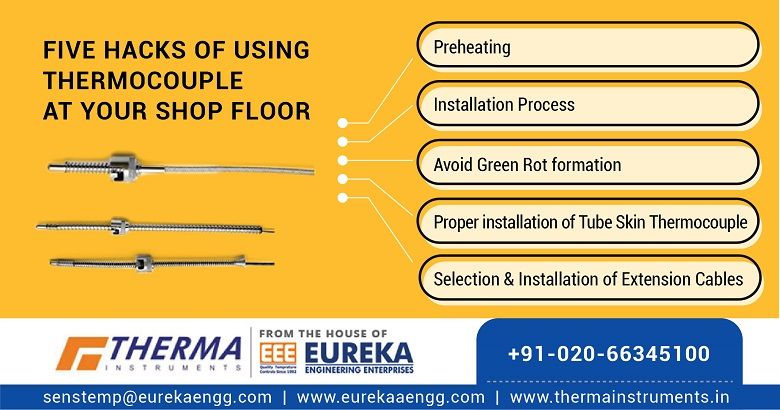Five Hacks of using Thermocouple at your shop floor
Published on April 09, 2020

As you know thermocouple is a temperature measuring instrument consisting of two different metals joined to form a junction. While using a thermocouple in any application it is important to understand how thermo couples operate. Because of its complex composition, the performance of a thermocouple may get affected to several factors in its design, positioning or its surroundings. To avoid this one must have proper understanding of factors that might affect Thermocouple performance. In this article we are going to highlight 5 such hacks you should use at your shop floor for optimum performance of a thermocouple and avoid any chances of errors.
Best 5 Tips to avoid errors in Thermocouple readings
1. Preheating of Ceramic sheath Thermocouples
Due to sudden change from low temperature to high temperature, certain non-metals like Ceramic, Silicon Carbide, and Silicon Nitride might undergo Thermal Shock, also known as cracking. Particularly Ceramic Tubes with very Low Thermal Shock resistance can undergo failure. To avoid this failure it is always advisable, not to insert a ceramic tube into a hot area rapidly.
The best way to do this is pre-heating of Thermocouple. Following is the procedure to properly pre-heat to avoid any damage.
- Pre Heat the thermocouple in an Oven up to 150 deg C
- Hold the Thermocouple above the molten Metal, in the air which is hot for about 3 minutes
- Insert the Thermocouple in the molten metal, very slowly, at the rate of One inch per 5 seconds.
2. Prefer Vertical installation over horizontal installation
Thermocouples can be installed either vertically or horizontally depending upon the process requirement. Especially Type K and Type N Thermocouples which are used o measure high temperature up to 1200 Deg C, needs to be installed properly.
Such thermocouple construction is typically a mineral insulated sensor housed inside a metallic protected sheath. The protections sheaths are Thick walled Pipes or Drilled bar.
In Horizontal installation, due its own weight of Protection sheath and high temperature, it starts bending. Over a period of time, the bending increases and will ultimately Damage the Sensor permanently.
Hence Vertical installation is preferable for very high temperature use to prevent sagging.
3. Proper installation of Tube Skin Thermocouple
Tube Skin Thermocouples are manufactured from mineral insulated cable. Especially designed for measuring accurately the surface temperatures of heat exchangers, boilers, fired Furnace Tube and other vessels. A proper procedure for selection and installation leads to accurate results. Some points to be considered are:
- Select the correct Thermocouple Mineral Insulated cable Sheath Material depending on the Process conditions and Applications. The material available is SS 310, Inconel 600, Hastelloy etc.
- Ensure that the weld pad curvature matches the process tube curvature
- Weld the Slit pad on the Process Tube (Pipe) and ensure direct contact of the M I hot junction onto the process tube surface for faster and accurate sensing.
- Direct Flame radiation from the burner flame on the Thermocouple will cause error in the measurement and cause early failure of Thermocouple. To avoid this fix & weld the refractory insulated heat shield over the Pad.
- Include Expansion coils as they allow thermal expansion of Thermocouple to protect it from Stress and Breakage.
4. Avoid Green Rot formation
Type K Thermocouples, when used over 800 Deg C are subjected to Oxidation over prolonged use. Oxygen reacts with the chromium, it changes to chromium oxide and a green scale starts to appear on the conductor. This is known as “Green Rot “.It may lead to significant measurement error and eventually damages the thermocouple in long run.
Preventive measures to avoid Green Rot formation;
- Remove the Thermocouple and clean the conductors and inside of protection tube, periodically, at least once a month.
- Introduce additional oxygen or inert gas inside the protection pipe / Thermo well.
- Replace the bare wire thermocouple with mineral insulated sensor.
5. Proper Selection & Installation of Extension Cables:
Thermocouple Extension wires are used to connect Thermocouples to Measuring Instruments which are located far away.
Fibre glass insulated cables are preferred for Indoor application having High temperature zone which are very close to the furnace. Having Stainless Steel Braid will protect the cable from Mechanical damage.
When it comes to outdoor applications at ambient temperature, moisture and water droplets can accumulate on the surface leading to lowered Insulation resistance and can cause error in the reading. These problems can be avoided by using Teflon- or PVC-insulated extension wire.
Use of colour code chart is suggested as IEC & ASTM color codes are different for the same type of Extension wire
Extension Cable conductors, even though they behave like Thermocouple wires, beyond 300 deg C, measurement accuracy ceases. Therefore, never use the Extension wire inside ovens or very close to furnace.
Eureka Engineering Enterprises, a leading temperature measurement instruments manufacturer in India, provides customize solutions for all your temperature sensing needs. Eureka Engineering Enterprises provides a wide range of temperature measurement instruments like Thermocouple Sensor, RTD, Thermowell, Temperature Indicators, Temperature Scanners, Temperature Controllers, etc.
Have Any Questions on temperature sensing and control systems
Ask Our Experts!
Recent Posts
Looking for high-grade Temperature Sensors and Thermocouples for Aluminum Smelters?
Looking for the Best Temperature Measurement Solutions for Your Cement Plant? Eureka Has Got You Covered!
Things to Remember for Selecting Right Thermocouple Sheath Material for Molten Metal
Things to Consider for Protective Coating on Thermocouple Sheaths
Things to remember for Choosing Thermocouple Connectors
Things to Remember while installing Thermocouples and RTDs with Compression Fitting
Ever Wondered How Thermocouple Works
Five Mistakes to Avoid when Using a Thermocouple
Five Hacks of using Thermocouple at your shop floor
All Rights Reserved © EUREKA ENGINEERING ENTERPRISES - 2019
Engineered by The Impals